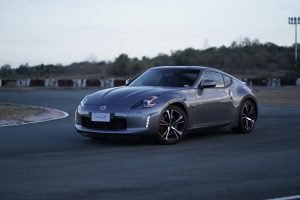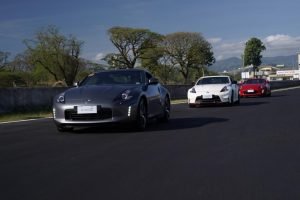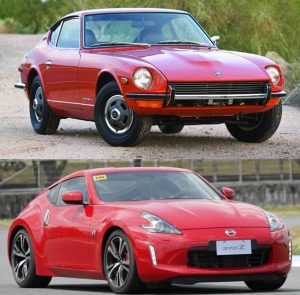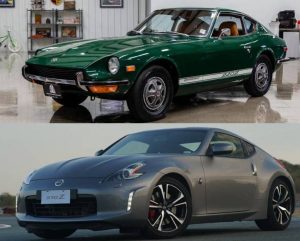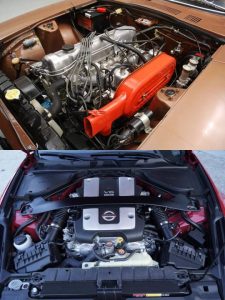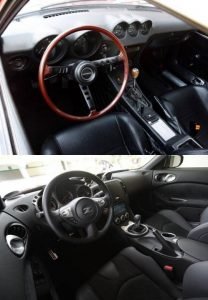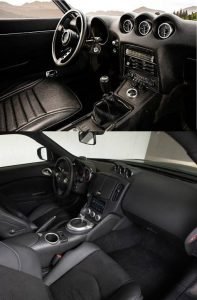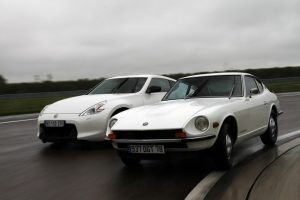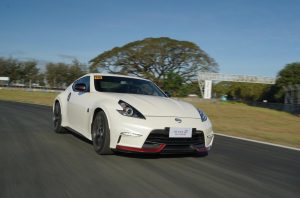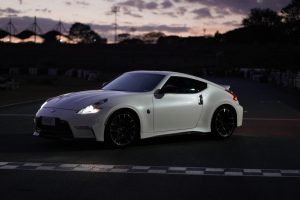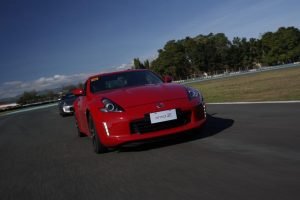Last March 11-12, Nissan Philippines Inc. (NPI) was planning to take members of the local motoring media, including yours truly, to a ride-and-drive experience at the Clark International Speedway (CIS) and around the former American airbase in Pampanga to introduce the 2020 Nissan 370Z two-seat sports car into the market. The official launch was supposed to be this April but the COVID-19 pandemic and the resulting Enhanced Community Quarantine (ECQ) spoiled all of NPI’s plans. Instead, NPI sent us several pictures that their official photographers took of the 370Z at CIS. Those lucky bastards…
While reviewing the press release that accompanied the photos that NPI sent us, we realized that Nissan’s iconic Z-car has been around for 50 years already. Half a century of performance is nothing to sneeze at (pardon the pandemic pun), especially with the technological advancements of the years in between. We decided that a comparison between the 1970 Datsun 240Z and its direct descendant, the 2020 Nissan 370Z Premium, is in order but with the ECQ still in force, we cannot just go out and compare the two cars side-by-side. All we can do is perform an armchair comparison, so here it goes:
When it was introduced in October 1969 as a 1970 model, the first-generation Datsun 240Z sported a sleek long-hood, short-deck design and a low roof line that car buffs found sexy and eye-catching; that owners found practical and attractive; and that engineers found aerodynamically efficient. The Nissan 370Z continues this tradition with a silhouette that still resembles the original Z-car but complies with the numerous occupant safety, crash safety, and pedestrian safety regulations imposed on the auto industry over the last 50 years. Nissan engineers were able to integrate a distinct bumper design with Bi-Xenon HID projector headlamps and LED Daytime Running Lamps (DRLs) into the 370Z’s sleek visage.
With the available automotive technology and manufacturing at the time, the first-generation 240Z was created for precise and balanced road holding for increased driving enjoyment. The latest generation of the 370Z, with its dual exhaust outlets and sleek rear spoiler, promises even quicker response and better handling with its low center of gravity, short wheelbase, and 19-inch RAYS forged alloy wheels shod in fat, meaty rubber. A responsive suspension system with sport-tuned shock absorbers and Nissan Sport Brakes delivers an adrenaline rush that the first gen Z-car, albeit a factory stock original, cannot match.
The Datsun 240Z relied on a twin-carburetor, overhead camshaft (OHC) 12-valve 2.4-liter inline 6-cylinder engine that churns out 151 horsepower and 198 Newton-meters of torque. The classic L24 inline-6 is mated to a 4- or 5-speed manual transmission or an optional 3-speed automatic transmission. In comparison, the Nissan 370Z is powered by a fuel-injected, double overhead camshaft (DOHC) 24-valve 3.7-liter V6 engine that makes 328 hp and 363 Nm of torque. The award-winning VQ37 V6 is mated to either a 6-speed stick shift with the world’s first SynchroRev matching system or a 7-Speed automatic with Downshift Rev Matching feature and controlled by magnesium paddle shifters. Power is delivered to the Limited Slip Differential though a strong and lightweight carbon fiber composite driveshaft.
The interior of the 240Z provided the occupants with ample room and comfort as well as some lateral support during cornering maneuvers. The driver grips a wood-rimmed 3-spoke steering wheel and shifts gears using a shift lever with a wooden knob. The driver-oriented cockpit of the new 370Z Premium mimics the dashboard design of the original 240Z, with its two large round binnacles housing the speedometer and tachometer and three smaller round binnacles housing other gauges.
The 370Z took a page from Porsche and positioned three gauges in the main binnacle, placing the large tachometer in the middle. Nissan kept the cockpit driver-focused with the angled triple meters but added comfort and convenience with 4-way power adjustable sport seats, 8-speaker Bose sound system, push start-and-stop button, and sports pedals. It did the 240Z one better with myriad active and passive occupant safety systems such as pretensioning sealbelts and multiple airbags. Overall, the interior of the 240Z is airy and classy but the 370Z’s is the safer place to be in.
After the ECQ is lifted and the pandemic is contained, we hope to be able to conduct a real, side-by-side comparison test between the 2020 Nissan 370Z and its iconic predecessor, the 1970 Datsun 240Z. We look forward to freely being mobile again, which we used to take for granted. We don’t know when the ECQ will be actually lifted or when the virus will be contained, but we’re keeping our fingers crossed. After all, we are firm believers in the saying, “Hope springs eternal”.
Now, what the new Z-car has over the original is its ability to spawn contemporary accessorized variants. Aside from the 370Z Premium, Nissan also offers the 370Z NISMO, which features exclusive NISMO accessories like front and rear bumpers, side sills, rear spoiler and door mirrors plus 19-inch RAYS forged alloy wheels with twin five-spoke design and a charcoal gray machine finish. A NISMO strut tower brace and performance dampers enhances handling while an exclusive NISMO dual exhaust system enhances engine power to 340 hp and 371 Nm of torque.
Inside, NISMO-styled elements include Recaro sport seats, a sports steering wheel wrapped in leather and Alcantara, and a red tachometer while NISMO badges permeate around the interior. All these NISMO accessories help increase excitement since 370Z NISMO is available only with the 7-Speed automatic transmission, which is rowed with black magnesium paddle shifters. “Nissan has a proven heritage of producing some of the most iconic sports cars in the world. We’re very excited to celebrate this legacy with the Nissan 370Z”, says Atsushi Najima, NPI President & Managing Director. “The 370Z showcases the perfect combination of practicality and performance and we’re happy to help Filipino enthusiasts realize their dream to own a proper sports car.”
Available at select Nissan dealerships nationwide, the Nissan 370Z Premium with 6-speed manual transmission is priced at P2,779,000 while the 7-speed automatic-equipped model is priced at P2,879,000. The Nissan 370z NISMO is priced at P3,888,000 and will be available exclusively at the Nissan High Performance Center in Nissan Quezon Avenue. For more information about the Nissan 370Z, please visit www.nissan.ph.
 Power Wheels Magazine A Notch Above
Power Wheels Magazine A Notch Above

